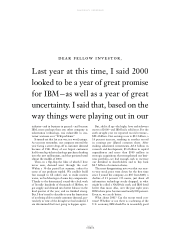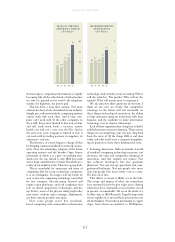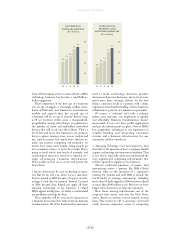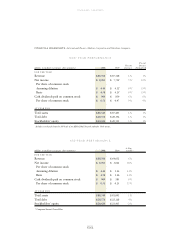IBM 2000 Annual Report Download - page 7
Download and view the complete annual report
Please find page 7 of the 2000 IBM annual report below. You can navigate through the pages in the report by either clicking on the pages listed below, or by using the keyword search tool below to find specific information within the annual report.
page no.
five
chairman’s foreword
competitive shape. Of course, we all hope such a
downturn doesn’t occur. But if it does, the ebbing
tide may not beach all boats. For one thing, services
offerings like outsourcing and hosting are cost-
saving propositions for our customers. Services, in
this regard, is a countercyclical business. And in a
tightening economic environment, customers are
going to invest in projects that deliver rock-solid,
tangible, near-term payoffs, not in speculative,
exploratory schemes. As a result, this may be a prime
opportunity for IBM to improve its market position.
THE DOT-COM CRASH: WHAT IT MEANS
That’s not the way things seemed a year ago. Back
then, it looked as though Internet start-ups were
taking over and traditional bricks-and-mortar
enterprises had better jump with both feet into
“e-tailing” or get steamrolled.
Well, as we all know today, it didn’t happen.
The crash brought out the usual pundits and
weathervanes
—
the same ones who a year earlier
had declared that dot-coms were taking over the
world. Only now they were saying, “This e-business
was mostly hype anyway. E-nough!”
Since, in many ways, IBM gave birth to all things
“e” five years ago, I’d like to offer a perspective.
The collapse of the dot-coms was not a failure of
e-business. It was the failure of an overly narrow
approach to e-business. For all the proclamations
we have been hearing about a “new economy,” the
problem with most dot-coms was that their business
model
—
win customers through lower prices
—
wasn’t anything new, not to mention transformative.
IBM has always said that e-business involves
more than transforming one part of a company,
such as selling directly over the Net. We said the
real action, the real work
—
and the ultimate payoff
—
involved the transformation and the integration of
the entire enterprise, from the customer all the way
through the supply chain. Things have played out
pretty much that way
—
and that may have been a
bucket of cold water for some. For IBM, it was a
tough but ultimately heartening reaffirmation of the
strategic direction we set in place several years ago.
So, if there is a lesson to be extracted from the
dot-com crash, it may be this: There is no short-cut
to e-business. And if 2000 comes to be seen as a
watershed (and I think it will), that will be because
this was the year the world’s established enter-
prises awoke to the true possibilities of e-business.
I believe a broad consensus has emerged that
e-business is just… business, real business. And
real business is serious work.
THE GAME TODAY
One word you heard a lot last year was “buzz.” It’s
what the cooler members of our industry were
supposed to create to get all their constituencies
excited about what they were doing. Unfortunately
for them, this isn’t a very buzz-y period for our
industry. In fact, it’s downright boring, but oh so
important for the future.
Customers tell us the battleground has shifted
to computing infrastructure. Of course, IBM is no
longer alone in saying that the PC era is over, nor
in pointing to the explosion in personal access
devices (as well as an even wider array of things
with embedded intelligence, such as appliances
and cars). Most of our competitors today are saying
that enterprise servers, storage and software are
key, and that they must be bulletproof, robust,
scalable, never-go-down. But I’m not sure we all
agree on what “infrastructure” actually means.
Businesses are coming to see that their computing
infrastructure cannot be designed or built around
any one product
—
or even any particular type of
technology, whether databases, or servers, or stor-
age. None of those tails can wag this entire dog.
For one thing, the pieces all have to work with one
another. For another, in order to function in the
real world
—
where there is a hodgepodge of exist-
ing systems within any company and among its
customers, suppliers and trading partners
—
they
have to take a broad view of the full spectrum of
infrastructure elements.
The point is, no company’s systems are an
island. They’re part of a new, emerging, global
infrastructure that is made possible by the emer-
gence of the Internet, and that no one enterprise
can
—
or wants to
—
own. It’s collectively owned,
accessed and relied upon by every business,
government, school, hospital and neighborhood.




















